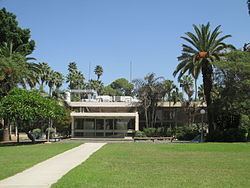District Northern Affiliation Kibbutz Movement Population (2015) 860 Founded 1926 | Council Jezreel Valley Founded by Immigrants from Pinsk Website www.gvat.org.il Local time Sunday 10:57 AM | |
 | ||
Weather 21°C, Wind SE at 27 km/h, 40% Humidity | ||
Gvat or Gevat (Hebrew: גְּבַת) is a kibbutz in northern Israel near Migdal HaEmek in the Jezreel Valley. It falls under the jurisdiction of Jezreel Valley Regional Council. In 2015 it had a population of 860. Gvat is the founder of Plastro, one of the world's largest drip irrigation systems manufacturers.
Contents
Map of Gvat, Israel
History
The kibbutz was established on 28 November 1926 by a group of Fourth Aliyah pioneers from Pinsk, Poland, on the land of the village of Jibta, which had been sold by the Sursock family and their partners to the Zionists.
In 1922, the first kibbutz members formed a kvutza in memory of the 35 members of the Jewish community of Pinsk killed by the Polish Army on 5 April 1919 during the Pinsk massacre. The kibbutz was named after Givta, a town located near Tzippori during the period of the Second Temple. In 1931 with the help of the Jewish National Fund and donations from Pinsk's Jewish community, a forest commemorating the victims of the Pinsk massacre was planted near Gvat.
The kibbutz was established on classical Zionist-Socialist principles and there has never been a synagogue in the village. Gvat was later joined by adherents of the Poalei Zion movement from Pinsk and its surrounding region, as well as by members of HeHalutz from Poland and Germany.
In 1951, following the split in the HaKibbutz HaMeuhad movement, some of Gvat's members left the kibbutz and together with members of Kvutzat HaSharon founded kibbutz Ihud HaSharon - Gvat, later renamed Yif'at in 1952.
On 6 October 1973, during the Yom Kippur War, Soviet-made surface-to-surface FROG-7 missiles launched by Syria struck Gvat, presumably aimed at a nearby airfield. Despite extensive damage to the buildings, there were no casualties, since the inhabitants had been sleeping in underground shelters.
Archaeology
Archeological evidence, including columns and masonry inscribed with Latin, shows that a first-century BCE Judeo-Roman settlement existed at the site.
Demographics
As of 2006 Gvat had a population of 670.
Economy
Irrigation equipment manufacturing company Plastro was established in 1966 by Kibbutz Gvat. Plastro is the world's second largest drip irrigation company after Netafim (also from Israel). Plastro and Netafim, together with Israel's other irrigation equipment company NaanDan Irrigation Systems, control roughly half the world market, worth from $1 to $1.5 billion a year.
In 2005 Australian billionaire John Gandel, acquired 50% interest in Plastro Irrigation Systems. But in May 2007 Kibbutz Gvat, using a loan from John Deere & Company, exercised an option to buy back the shares.
In 2008 Kibbutz Gvat agreed to sell its 75.1% stake at Plastro Irrigation Systems Ltd to John Deere at a company value of NIS 265 million. John Deere was obliged to leave Plastro at the kibbutz employing Kibbutz Gvat members for 15 years. Also John Deere agreed to pay Gvat $1.3 million annually over ten years for a non-competition agreement. In exchange Kibbutz Gvat agreed to cease receiving management fees for Plastro.
Another sector of Gvat's economy is agriculture. Field crops, citrus fruit, dairy, poultry, ostriches are also farmed and produced in Gvat.
Culture
Kibbutz Gvat runs Bet Herschel theater, named after one of the kibbutz founders, where movies and stage productions are shown. The kibbutz also has a regional sports center.
There are monuments in Gvat commemorating those who perished during the Holocaust and the Pinsk massacre.
A member of Gvat wrote in 1940 the song about the green truck that picks up milk and eggs from one kibbutz after the other and takes them to the Tnuva factory, a song which is until today known by virtually every Israeli young child.
